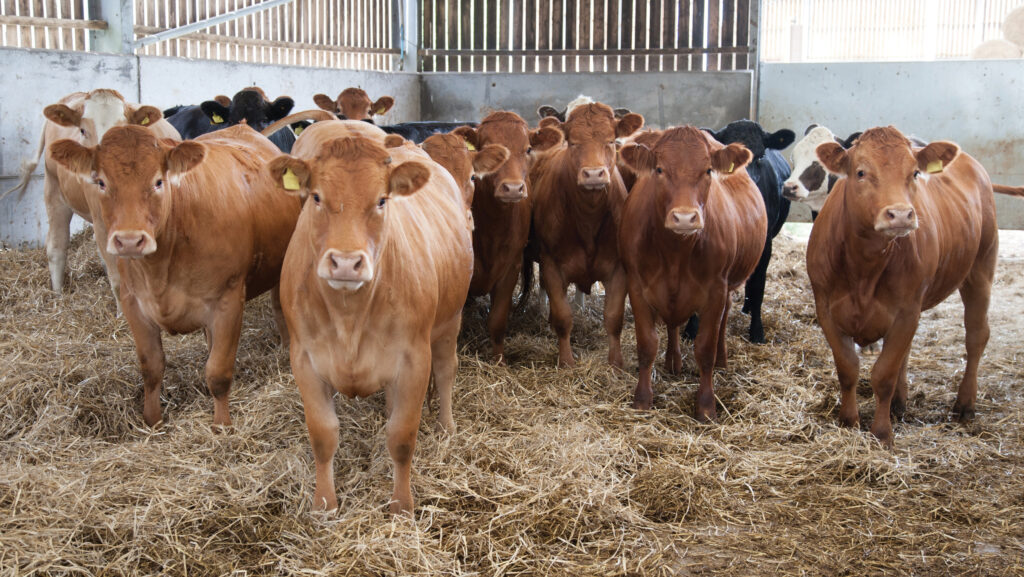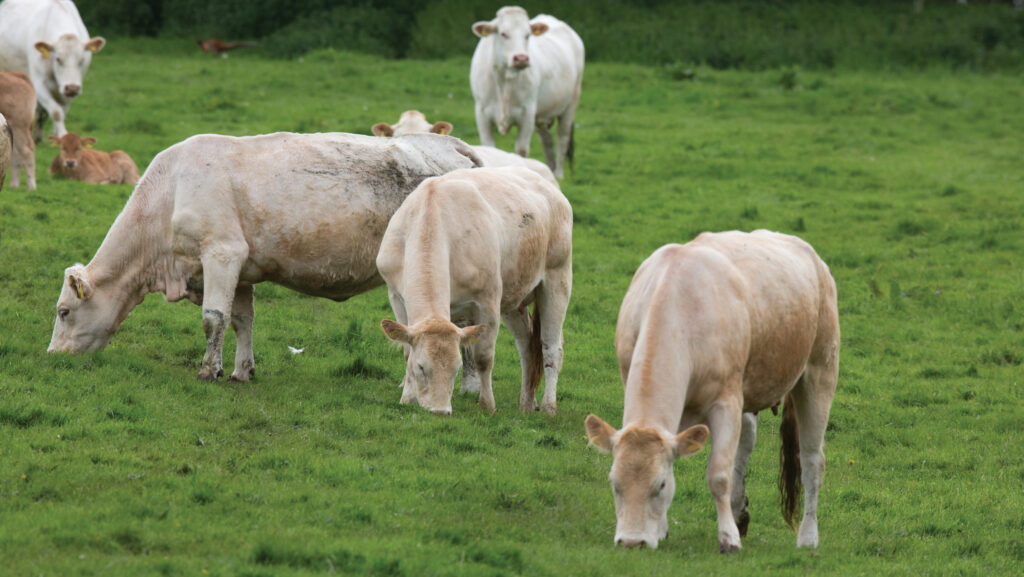Tips on essential beef production costings
 © Tim Scrivener
© Tim Scrivener Making a profit from beef remains a constant challenge, despite finished prices tracking 30% higher than a year ago.
The outlook is for strong trade to continue on the back of relatively good demand and tight supply.
However, costs continue to rise, especially overheads, so accurate costings are as important as ever, say advisers.
See also: Integrated beef schemes what’s available and how they work
Based on his experience giving free farm business advice through Defra’s Future Farm Resilience Fund, Adas consultant James Dunn says far too few beef producers undertake any sort of costings exercise.
Better beef prices can mean that the focus on costs relaxes or that investment is encouraged which can turn what promises to be a good year into a poor one, he warns.
James, who is technical director of business management for Adas, farms with his two sons, Andrew and David, in North Lincolnshire, where they will finish about 400 head of beef this year.
About 60 of these are Stabiliser bulls and heifers produced by their own 80-head suckler herd, with a further 80-90 head of bought in Stabiliser bulls.
The remainder are beef calves from the dairy herd for integrated beef schemes.
The family also runs a 1,000-pig place B&B unit putting through 2.5 batches a year, alongside sunflower and pumpkin enterprises, and manages an AD plant for a neighbour.
Beef market background
- UK clean beef steer slaughterings in June 2025 were 7.5% lower than in the same month last year, while heifer slaughtering was down 1.9% and 2.1% fewer young bulls were killed
- Store cattle trade has dropped back in some areas on limited grass availability
- Summer often sees a seasonal fall in beef prices, with lower consumer demand for prime cuts due to people taking holidays abroad
- In the 12 weeks to mid-June average retail prices for total beef products increased by 10.4% year-on-year, while the volume bought fell 3.6% (-4,747 tonnes) and the amount spent on beef rose 6.3%, according to retail analyst Kantar. Mince and steak volumes fell but roasting joint sales rose.
Market awareness
As well as a lack of costings, there is also an issue with market awareness, says James, with some farmers producing a bigger animal than the general retail sector wants.
“That’s fine if you have a local butcher market that wants these, but it’s a false economy to put them into the commercial retail market.”
James is also keen to see more work done on beef quality and taste, alongside bringing consumers and farmers together.
Costings from scratch
Calculating the true cost of production can become complex, he says, but gross margins are a good place to start. Allocating direct variable costs such as feed, bedding, vet, medicines and sundries to an enterprise can be done per batch of cattle or on an annual basis. James suggests costing by the batch is best so that one group can be compared with another.
“Comparisons are important, so stick to one methodology,” he says.
“That’s not so easy with sucklers, as they are mainly on forage, which is an enterprise in itself, so as well as the annual cost of fertiliser and other direct inputs like silage making, there are other parts to it such as reseeding and fencing costs and this should be costed as a separate enterprise and allocated to the suckler enterprise according to the proportion it accounts for.”
Full cost of production
A full cost of production calculation is more useful but more complex and so the danger is that it simply doesn’t get done, says James.
This needs to include labour (and a sum to represent unpaid family labour), finance, rent, fuel, electricity, machinery, water, depreciation and other overheads such as insurance, property costs and other general overheads of running a business, for example phone bills and admin costs.

© Tim Scrivener
“Allocating these costs between enterprises accurately can be tricky, so one way to do it is to allocate on the basis of turnover. That way, 100% of the overheads will be covered.”
For example, if beef finishing represents 35% of turnover, allocate 35% of overheads to that enterprise.
An alternative is to allocate overheads according to the labour units used by each enterprise.
Costs often missed
Commonly forgotten items in production cost calculations include elements such as labour, depreciation, finance charges, fuel, water, electricity and rent for land or buildings, says James.
Benchmarking is useful to compare your performance against that of similar farms, he says, but the most important thing is to benchmark against yourself, for example batch-by-batch of cattle so that you know what was different and what worked well or poorly.
His budgeting tips include buying feed forward to help lock in costs. However, he cautions against feed shortcuts.
“Never save on quality of feed or types of ingredients to deliver a palatable and effective feed source,” he says.
Set targets
A key target for many producers should be store prices. “Set a target and stick to it,” says James.
“When is it too expensive, and what secondary enterprise could fill that cash gap if stores are beyond your target? Have a contingency.”
Consider integrated beef schemes
Integrated schemes – often run by processors, such as Myton Food Group which supplies Morrisons – can reduce the cash requirement and market price risk. But weigh up carefully which might suit your business best, advises James.
The schemes vary and may involve contract rearing where no direct farmer investment is required in the stock itself, through to those where the farmer buys the stock and is given a set price for an agreed finished weight.
These can reduce the cash requirement and market price risk but weigh up carefully which might suit your business best, advises James.
“They are especially useful for those who are starting out in beef.”
Technical support
Cloud accounting is useful for ease of recording and flexibility. It involves managing records and financial data using internet-based software, such as Xero, rather than a program on a local computer.
This is convenient and gives access from any device with an internet connection.
Improvements such as better maize varieties, which can be grown further north, change the dynamics of beef production.
James also highlights innovations such as Keenan’s Pace system, which helps with accurate feed mixing, recording and costing.
Cashflow
A 24-month cashflow projection is advisable, says James. As long as the actual position is monitored against the projection, then adjustments can be made.
“For example, perhaps not buying in or keeping on as much stock as originally planned. Could a shorter keeping time or alternative enterprise fill a gap in the cashflow? It might not be as profitable but it could help.”
Farmbench beef finishing results – year ended November 2024 |
||
|
Per head of output – key performance indicators |
2022-23 |
2023-24 |
|
Cost of production (£/kg) |
2.55 |
2.70 |
|
Cost of production £ a head a day |
7.79 |
8.39 |
|
Daily liveweight gain (kg/day) |
0.79 |
0.85 |
|
Value of all sales/transfers and closing stock (£/kg liveweight) |
2.50 |
2.69 |
|
Weight produced per forage hectare (kg/ha) |
761 |
813 |
|
Non-forage feed fed freshweight (kg a head) |
1,037.81 |
1,487.23 |
|
Non-forage feed fed dry matter (kg a head) |
759.27 |
836.25 |
|
Non-forage feed cost (£/t) |
171.17 |
95.45 |
|
Harvested forage fed freshweight (kg a head)
|
1,489.53 |
1,736.19 |
|
Harvested forage fed dry matter (kg a head) |
499.30 |
556.06 |
|
Total income (£ a head of output) |
1,459.81 |
1,567.68 |
|
Total variable costs (£ a head of output) |
1,035.92 |
1,143.35 |
|
Total feed and forage costs (£ a head of output) |
198.97 |
168.96 |
|
Total overheads (£ a head of output) |
240.10 |
239.53 |
|
Full economic cost of production (£ a head of output) |
1,474.99 |
1,551.83 |
|
Full economic net margin (£ a head of output) |
-15.18 |
15.84 |
|
Source: AHDB Farmbench |
||
Latest Farmbench resuts
The latest AHDB Farmbench results, for 2023-24 and covering the year up to and including uutumn 2024, will be out in full in a few weeks’ time.
An early look at finishing performance for that year shows a slight improvement on 2022-23, producing an average net margin of almost £16 a head compared with a loss of more than £15 a head in the previous year.
This is after calculating the full economic cost of production, including machinery and buildings depreciation and imputed values for unpaid labour and rental values/owned equivalent values.
Among sucklers, the average herd in severely disadvantaged areas (SDAs) saw higher costs in 2023-24 compared with the previous year. A significant rise in overheads was driven largely by higher labour, machinery, and rental values.
Lower fertility rates and higher mortality resulted in fewer calves at weaning. Despite this, a 25% increase in the value of calves at weaning led to higher income per cow put to the bull.
However, this rise in income was not enough to offset higher costs, resulting in an average loss of £224 a cow in 2023-24, up from £125 in 2022-23.
The top 25% of SDA herds did make a small profit – £64 a cow – on higher income and lower costs compared to other herds.
Overhead control is key to profitability in cattle enterprises, says the AHDB, and while Farmbench figures suggest economies of scale are important, they do not always lead to a reduction in cost of production.
Previous years’ results have shown the top 25% have higher scanning and calving numbers alongside lower mortality levels in calves, resulting in a higher number of calves at weaning, leading to higher total incomes.
Among non-SDA herds, the average loss was £78 a cow, an improvement on the £223-a-cow loss in the previous year.
The top 25% of non-SDA herds averaged a £217-a-cow profit, on lower costs in all areas.
